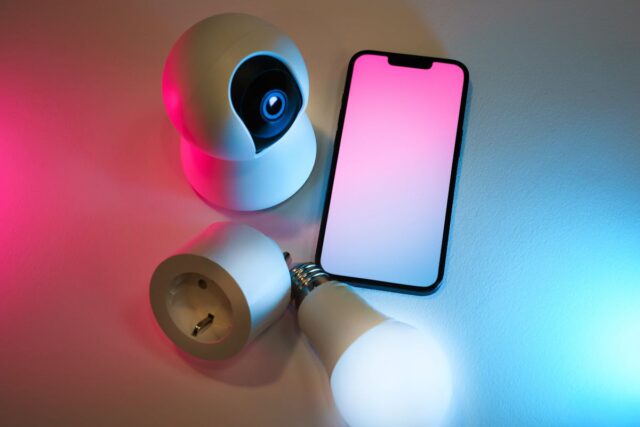Smart homes are no longer a futuristic concept. They are here, transforming how we live. Smart device integration is at the heart of this revolution. It allows you to connect various devices seamlessly, creating a unified smart home experience. Let’s dive into the essentials.
What Is Smart Device Integration?
In simple terms, it is the process of connecting different smart home devices so they work as a single ecosystem. From smart speakers to security cameras, integration ensures smooth communication between devices. The Internet of Things (IoT) plays a key role in enabling this functionality.
How Smart Devices Connect to Your Home
Devices typically use technologies like:
- Wi-Fi: Ideal for large data transfers.
- Bluetooth: Great for close-range communication.
- Zigbee and Z-Wave: Preferred for low-power, efficient networks.
Choosing the right connection type is crucial for seamless integration.
The Role of IoT in Smart Device Integration
IoT enables devices to share data and automate tasks. For instance, a smart thermostat can adjust the temperature based on sensor data from your smart home hub.
Why Integrating Smart Devices Matters
Integration is more than convenience. It’s about creating a connected smart home that works efficiently.
Benefits of a Connected Smart Home
- Convenience: Control all devices with a single app or voice command.
- Efficiency: Optimize energy usage with integrated systems like smart lights and thermostats.
- Security: Get instant alerts from connected smart security systems.
How Automation Enhances Convenience and Efficiency
With automation, your devices work together intelligently. For example, when you leave home, your smart lock can secure the door, and your smart thermostat can lower energy usage.
Top Smart Home Devices for Seamless Integration
Creating a smart home starts with choosing the right devices. Here are some popular categories and examples.
| Device Type | Example | Features |
| Smart Hubs | Amazon Echo, Google Nest | Centralized control, voice assistance |
| Smart Thermostats | Nest Learning Thermostat | Energy saving, remote control |
| Smart Security Cameras | Ring, Arlo | Motion detection, live streaming |
| Smart Lights | Philips Hue, LIFX | Color customization, scheduling |
Invest in devices that align with your needs and are compatible with Alexa or Google Assistant.
Best Smart Home Hubs for 2025
A smart home hub is the backbone of your setup. It connects all your devices, ensuring smooth communication. Popular options include Amazon Echo, Samsung SmartThings, and Google Nest Hub.
Must-Have Devices for Home Automation
Start small. Invest in devices like smart plugs, smart lights, and voice assistants. These are easy to integrate and provide immediate benefits.
How to Set Up and Manage Your Smart Devices
Setting up your devices can be simple with the right approach.
Step-by-Step Guide to Device Integration
- Choose a Smart Hub: Select a hub compatible with your devices.
- Install the Devices: Follow the manufacturer’s instructions.
- Connect to the Hub: Use the app to pair devices.
- Customize Settings: Set up automations like schedules and routines.
Troubleshooting Common Connectivity Issues
- Check Compatibility: Ensure your devices support the same protocol.
- Restart Devices: Power cycling often solves connectivity problems.
- Update Firmware: Keep your devices updated for optimal performance.
Choosing the Right Smart Home Ecosystem
Not all ecosystems are created equal. Compatibility is key.
Zigbee vs. Z-Wave: Which One Is Better?
Both are excellent, but their strengths differ:
- Zigbee: Faster, better for high-density networks.
- Z-Wave: More reliable, better range.
Choose based on your home’s size and device requirements.
Compatibility with Alexa and Google Assistant
Most devices today are designed for voice assistant compatibility. Check labels to ensure seamless operation with your preferred assistant.
Smart Home Security and Privacy Tips
Security is essential when integrating multiple devices.
Securing IoT Devices in Your Home
- Use Strong Passwords: Avoid default credentials.
- Enable Two-Factor Authentication: Adds an extra layer of security.
- Update Regularly: Ensure your devices have the latest security patches.
Avoiding Integration Pitfalls and Vulnerabilities
Plan your setup carefully. Avoid mixing devices with incompatible standards. Research thoroughly before purchasing.
The Future of Smart Device Integration
Technology is evolving, and so are smart homes.
Trends in Home Automation Technology
Expect more AI-driven features and cloud-based systems that learn your habits. Energy-efficient smart homes are also gaining traction.
AI and Cloud-Based Smart Systems
AI-powered hubs can predict your needs. Cloud systems allow remote control, making your smart home more intuitive.
FAQs on Smart Device Integration
What Devices Work Best for Beginners?
Start with smart plugs, voice assistants, and smart lights. They’re affordable and easy to set up.
How to Upgrade Your Existing Smart Home System?
Add compatible devices gradually. Focus on hubs and protocols to ensure smooth integration.
What Are the Key Challenges of Smart Device Integration?
The main challenges are device compatibility, security concerns, and maintaining a reliable connection.
How Can I Make My Smart Home Energy Efficient?
Integrate devices like smart thermostats, lights, and energy-monitoring plugs to reduce consumption.























